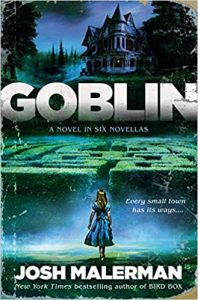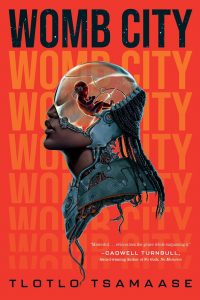Gabino Iglesias Reviews Goblin by Josh Malerman
 Goblin, Josh Malerman (Earthling 978-0-9962118-5-7, $50.00, 376pp, hc) October 2017. (Del Rey 978-0-593-23780-3, $28.00, 416pp, hc) May 2021. Cover by Deena Warner.
Goblin, Josh Malerman (Earthling 978-0-9962118-5-7, $50.00, 376pp, hc) October 2017. (Del Rey 978-0-593-23780-3, $28.00, 416pp, hc) May 2021. Cover by Deena Warner.
With Goblin, Josh Malerman joins the select group of authors who have given readers a memorable fictional town that will forever mark a spot in the literary map of our minds. Like Gabriel García Márquez’s Macondo or Stephen King’s Castle Rock, Malerman’s Goblin feels like a real place, complete with a complicated, bloody history that mirrors that of many other towns, as well as residents that bring it to life. Also, just like those other towns, Goblin is a place in which magic is real and strange things happen.
Goblin is a novel about a place, its haunted history, and its people, told through six novellas. “A Man in Slices” is a tale of friendship and love that quickly morphs into a story of sacrifice, strange love, and mutilation. At once heartwarming in its exploration of how outsiders find each other and gritty in the way it exposes what obsession might push some people to do, this one is a great start to a book that only gets better. “Kamp” tells the story of Walter Kamp, a paranoid, lonely man who is afraid of everything and who takes every conceivable measure to prevent scary moments because he is afraid of being scared to death, but there are things worse than being scared, and what we often think will scare us is often insignificant in comparison to what’s really out there. “Happy Birthday, Hunter!” follows Neal Nash, a big-game hunter and one of Goblin’s most well-known residents, as he sets out to hunt the ultimate prey: the Great Owl, a legendary – and illegal to hunt – bird that inhabits Goblin’s dark forests and that is tied to the roots of the town. Unfortunately for Nate, the woods in which the Great Owl hides contain much more than birds, and the darkest bits of Goblin’s history are not only true but also dangerous. “Presto”, which could easily be called the crowning jewel of the novel, simultaneously chronicles the struggles of Peter, a young boy obsessed with magic who wants to see a show coming to town, and the life, career, and mysterious gift of Roman Emperor, the superb magician Peter idolizes and a man who must constantly pay for his magical prowess. “A Mix-Up at the Zoo”, which is darker and more depressing that anything else in Goblin, follows Dirk Rogers, a man who becomes the new zookeeper in town. As Dirk’s inner world collapses due to stress and depression, reality and what lies behind it mix in unexpected ways. Finally, “The Hedges” takes readers deep into a hedge maze and the life of the man who built it for his dead wife after a young girl cracks its code and finds the dark secret the maze hides at its core.
Goblin is a superb Frankenstein’s monster held together with a series of cohesive elements that manage to make the six novellas, and the story that bookends them, feel like a single narrative. Malerman repeatedly mentions the same people, the folklore of the town, and the same buildings. This makes the stories fit together. However, there are other elements that truly bring the narratives into the same universe and grant them the same underlying atmosphere. The first one that merits attention is the rain, which is an oppressive, ever-present, pervasive presence. The sound of it to a Gobliner is “as commonplace as a train in the metropolis.” The rain is always there, and it often becomes a character, a living entity that never speaks but that either hides something or tries to warn us of something.
The second element is Goblin’s police force. The cops in Goblin all look alike: “long faces, long arms, sunglasses. And skin that looked more like putty than flesh.” They have strange voices and act like ghosts trying to protect a secret agenda. Every time they’re mentioned or show up, the narrative drops further into murky darkness. More than strange men, they embody the creepy, supernatural vibe that permeates the town.
Malerman does many things right here, but Goblin, like a good monster, is much more than the sum of its parts. For example, there is an emotional depth that runs through all the narratives and that makes character development one of the best things in all the novellas. Because there are half a dozen different stories in this novel, there are many main characters, but they are all distinctive and have backstories that allow them to shine brightly in the time they spend in the spotlight. Malerman seems to have understood one of the most important rules of horror fiction: there can be no true horror in the absence of empathy, and he spends a lot of time making sure we know, and care, about the people he brings to life in his work.
While each of the narratives in Goblin feels unique, the history of the place, which goes back to when Native Americans populated the area, permeates all of them. Between that history, the buildings and streets described, and things like the rain, Goblin feels much bigger than what we see in the pages of this novel, and that feeling quickly morphs into an immersive reading experiences that’s hard to leave behind, making this lengthy novel read like a single novella; it’s fast, and it’s over too quickly. Malerman opened a lot of doors in Goblin and pulls readers through them into eerie realities. However, we know there’s much more out there, and Goblin achieves something special: it leaves readers wishing the author will take them there again.
Gabino Iglesias is a writer, journalist, professor, and book reviewer living in Austin TX. He is the author of Zero Saints and Coyote Songs and the editor of Both Sides. His work has been nominated to the Bram Stoker and Locus Awards and won the Wonderland Book Award for Best Novel in 2019. His short stories have appeared in a plethora of anthologies and his non-fiction has appeared in the New York Times, the Los Angeles Times, and CrimeReads. His work has been published in five languages, optioned for film, and praised by authors as diverse as Roxane Gay, David Joy, Jerry Stahl, and Meg Gardiner. His reviews appear regularly in places like NPR, Publishers Weekly, the San Francisco Chronicle, Criminal Element, Mystery Tribune, Vol. 1 Brooklyn, the Los Angeles Review of Books, and other print and online venues. He’s been a juror for the Shirley Jackson Awards twice and has judged the PANK Big Book Contest, the Splatterpunk Awards, and the Newfound Prose Prize. He teaches creative writing at Southern New Hampshire University’s online MFA program. You can find him on Twitter at @Gabino_Iglesias.
This review and more like it in the August 2021 issue of Locus.
 While you are here, please take a moment to support Locus with a one-time or recurring donation. We rely on reader donations to keep the magazine and site going, and would like to keep the site paywall free, but WE NEED YOUR FINANCIAL SUPPORT to continue quality coverage of the science fiction and fantasy field.
While you are here, please take a moment to support Locus with a one-time or recurring donation. We rely on reader donations to keep the magazine and site going, and would like to keep the site paywall free, but WE NEED YOUR FINANCIAL SUPPORT to continue quality coverage of the science fiction and fantasy field.
©Locus Magazine. Copyrighted material may not be republished without permission of LSFF.






